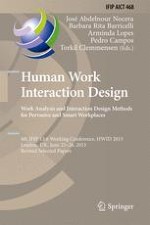2015 | Buch
Human Work Interaction Design. Work Analysis and Interaction Design Methods for Pervasive and Smart Workplaces
4th IFIP 13.6 Working Conference, HWID 2015, London, UK, June 25-26, 2015, Revised Selected Papers
herausgegeben von: José Abdelnour Nocera, Barbara Rita Barricelli, Arminda Lopes, Pedro Campos, Torkil Clemmensen
Verlag: Springer International Publishing
Buchreihe : IFIP Advances in Information and Communication Technology
